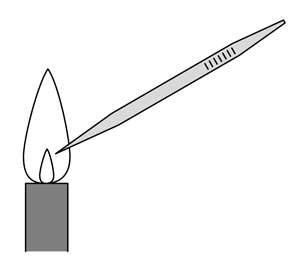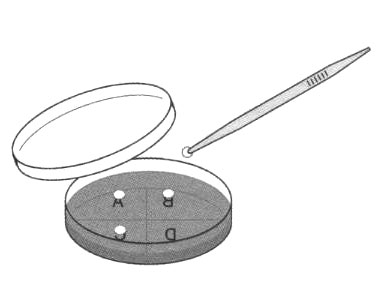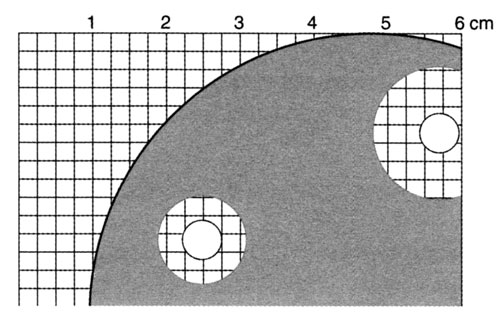Digestion of starch: microbes
Class practical
This activity involves skills for safe handling of microbial material. Students compare the activity of an enzyme extract with that of two enzyme-producing bacteria and can consider the industrial importance of enzymes and microbes.
 This practical is based on an investigation called
This practical is based on an investigation called ![]() Breakdown of starch by microbes published in Practical Microbiology for Secondary Schools © Society for General Microbiology.
Breakdown of starch by microbes published in Practical Microbiology for Secondary Schools © Society for General Microbiology.
Lesson organisation
Give each working group (1-2 students) a starch-nutrient agar plate. They will have to use sterile paper discs to collect samples of two bacteria and one enzyme extract, all using sterile technique. Organise the work so that not all the groups want bottle A at the same time!
Written information about industrial processes using microbes and enzymes, particularly amylases for starch processing, would be a useful resource for this lesson. See Web links at end.
There is scope here for developing skills of aseptic technique to become the focus as well as exploring the enzyme activity.
Apparatus and Chemicals
For each group of students:
Forceps (1)
Sterile paper discs (4)
Ruler (1)
Marker pens to label the plates
Tape to close the plates (Note 3)
For the class – set up by technician/ teacher:
Bacillus subtilis nutrient broth culture, 2 cm3 in a bottle/ test tube
Escherichia coli nutrient broth culture, 2 cm3 in a bottle/ test tube
Starch-nutrient agar plates, 2 per group (Note 1)
VirKon solution 1% w/v (see manufacturer’s instructions) (Note 2)
Bottles of sterile distilled water, 1 per 4 groups
Bottles of 0.1% amylase solution, 1 per 4 groups
Health & Safety and Technical notes
Carry out a full risk assessment before planning any work in microbiology (Note 1 for more details).
Check the standard techniques for more details of Aseptic techniques, Making up nutrient agars, Pouring an agar plate, Maintaining and preparing cultures and Incubating and viewing plates safely.
Wear eye protection when handling iodine solution to test for starch.
1 Before embarking on any practical microbiological investigation carry out a full risk assessment. For detailed safety information on the use of micro-organisms in schools and colleges, refer to Basic Practical Microbiology – A Manual (BPM) which is available, free, from the Society for General Microbiology (email This email address is being protected from spambots. You need JavaScript enabled to view it.) or go to the safety area of the SGM website (http://www.microbiologyonline.org.uk/teachers/safety-information) or refer to the CLEAPSS Laboratory Handbook, section 15
2 Make nutrient agar into starch-nutrient agar following the recipe in Standard techniques: Making up nutrient agars.
3 Suitable disinfectants include sodium chlorate(I) (hypochlorite) at concentrations providing 1000 ppm available chlorine for general surface cleaning, or 2 500 ppm chlorine for discard pots, or VirKon (follow manufacturer’s instructions).
4 Make up 0.1% amylase solution or use purchased stock. See CLEAPSS Hazcard and Recipe card. Powdered enzyme is harmful, but solutions less than 1% are considered low hazard. Make up fresh for each day of use as it degrades over time.
5 Make your own assay discs by punching discs around 6mm diameter from filter paper, or chromatography paper using a cork borer or a hole punch. Wrap in aluminium foil, in sets of four, and sterilise by autoclaving.
6 Make up iodine solution. See CLEAPSS Hazcard and Recipe card. A 0.01M solution is suitable for starch testing. Make this by 10-fold dilution of 0.1M solution. Once made, the solution is a low hazard but may stain skin or clothing if spilled and may irritate the eyes.
Procedure
SAFETY:
Handle all cultures of microbes according to good laboratory practice.
Wear eye protection when handling iodine solution.
Preparation
a Inoculate nutrient broth with fresh cultures of Bacillus subtilis and Escherichia coli at least 48 hours before use. (See Standard technique: Maintaining and preparing cultures)
b Calculate the quantity required and prepare just enough starch-agar for the investigation (12-15 ml for normal depth in a 90 mm Petri dish). Any surplus will keep for 6-12 months in tightly-sealed screw-top bottles if sterile.
c Prepare a suitable solution to disinfect the work area for the investigation and afterwards (Note 3).
d Prepare 0.1% amylase solution (Note 4).
e Sterilise distilled water in enough McCartney/ Universal bottles.
f Paper discs can be purchased (Whatman Antibiotic Assay discs) or you can make your own (Note 5).
g Stop the growth of the culture before the students inspect the plates. Refer to standard procedure Incubating and viewing plates.
h Make up iodine solution (See CLEAPSS Hazcard and Recipe card).
Investigation
a Keep one starch-nutrient agar plate unopened as a control. Flood with iodine at the same time as the other plates.
b Provide each working group with one starch-agar plate.
c Students use a marker pen to mark four sections on the base. Label the sections A, B, C, and D. Write a key to record the treatment of each disc, for example
| Area | Treatment |
| A | Bacillus subtilis |
| B | Escherichia coli |
| C | 0.1% amylase solution |
| D | Distilled water |
d Pass the forceps through a Bunsen burner flame. Allow them to cool and use them to pick up one of the paper discs.

e Open a bottle containing bacterial culture (or remove the cotton wool stopper from the test tube). Flame the neck and dip the disc into the broth. Allow excess to drip off. Flame the neck again and replace the top or stopper. Transfer the disc to the middle of the correct section on the agar plate.
f Repeat d and e using another disc and the other bacterial culture.
g Repeat d and e using another disc and the amylase solution.
h Repeat d and e using another disc and the distilled water.

i Place the forceps in a discard beaker.
j Tape up the dish and incubate the plates (see Standard techniques).
k After 2-3 days, technically-qualified staff will kill the culture.
l Open the Petri dish and use a dropper to put in just enough iodine solution to cover the surface of the agar. Replace the lid.
m Put the dish on squared paper. Measure and record the diameter of any clear zones around the discs. A wider diameter suggests a greater concentration of amylase.

Teaching notes
This protocol introduces a quantitative assay technique for enzyme activity. It is worth discussing the value and limits of this as a technique.
The fact that enzymes (of microbial origin) will digest starch to produce sugars is important to the starch-processing industry – manufacturing sugars and syrups for foods, beverages and possibly biofuels. A text-based exercise, such as gathering useful information and making notes from a complex source, would be a useful companion to this practical work.
Amylase breaks down starch molecules to sugars. We produce amylase (in our saliva and pancreatic secretions) to break down the starch we eat. Some microbes also produce amylase. These enzymes are secreted by microbes to digest large external starch molecules. The microbes then absorb the sugars produced, because they are small enough to pass into their cells.
Health & Safety checked, May 2009
Downloads
Download the student sheet ![]() Digestion of starch: microbes (180 KB) with questions and answers.
Digestion of starch: microbes (180 KB) with questions and answers.
Web links
www.microbiologyonline.org.uk/teachers/resources
Society for General Microbiology – source of Basic Practical Microbiology, an excellent manual of laboratory techniques and Practical Microbiology for Secondary Schools, a selection of tried and tested practicals using microorganisms. This protocol is based on Breakdown of starch by microbes.
www.microbiologyonline.org.uk
MiSAC (Microbiology in Schools Advisory Committee) is supported by the Society for General Microbiology (see above) and their websites include more safety information and a link to ask for advice by email.
www.ncbe.reading.ac.uk/NCBE/PROTOCOLS/pracbiotech.html
The NCBE is a rich source of up-to-date protocols and practical equipment for biotechnology practicals in schools. These notes (from 1993) cover enzyme reactions processing sugars in Better milk for cats and Glucoamylase production by yeast. The latter uses a bioreactor in which yeast ferments a starch suspension that can be sampled periodically.
www.lsbu.ac.uk/biology/enztech/starch.html
One example of the kind of information available about enzymes and industrial starch-processing.
www.jstage.jst.go.jp/article/jbb/94/6/94_526/_article/-char/en
Abstract of article in Journal of Bioscience and Bioengineering showing the importance of enzymes in starch processing and indicating the economic significance of such processes.
(Websites accessed October 2011)


